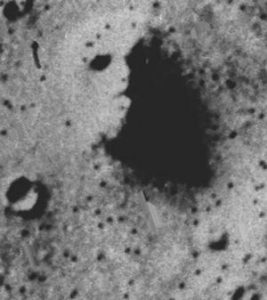 What would you think if a scientist declared that an ancient civilization on Mars had died at the hands of nuclear destruction? On the face of it, the concept seems inconceivable. Yet a physicist named Dr. John Brandenburg is claiming just such an occurrence around 200 million years ago on the Red Planet.
What would you think if a scientist declared that an ancient civilization on Mars had died at the hands of nuclear destruction? On the face of it, the concept seems inconceivable. Yet a physicist named Dr. John Brandenburg is claiming just such an occurrence around 200 million years ago on the Red Planet.
How did Dr. Brandenburg arrive at such a conclusion? Well, it all has to do with the isotopes. An isotope is an aberration in an atom wherein it has a different atomic weight than most others of its kind, usually due to one or more extra neutrons. Well, it seems there’s a preponderance of Xenon 129 and Argon 40 isotopes in the Martian atmosphere and in meteorites from Mars. Moreover, this type of isotopic signature is known to exist in only one other place in the solar system—hydrogen bomb test sites on Earth. Taken together, Dr. Brandenburg is struck by the likelihood that the once warm, wet planet suffered a nuclear catastrophe eons ago.
There is the possibility that uranium deposits or plutonium deposits in the Martian soil went critical in what is a naturally occurring nuclear event. While such an event may account for the level of destruction seen in the Martian biosphere, according to Dr. Brandenburg, it doesn’t account for distribution of isotopic anomalies. Given that these isotopes exist in the Martian air sampled by our rovers and in meteorites from Mars found here on Earth, the more probable nuclear event is a mid-air explosion that polluted the atmosphere and then settled into the sedimentary rock layers.
With all this in mind, Dr. Brandenburg is forced to draw the conclusion that the Mars nuclear event did not occur naturally, but was a manufactured event—leading to the inevitable question: Who the hell had the nuclear capability to destroy a planet some 200 million years ago?
In arriving at an answer to that audacious question, Dr. Brandenburg looks to the remnants of what appear to be large architecture on Mars. I’m sure you’ve all seen pictures of the Face on Mars and various pyramidal structures there. Whether these are actually fabricated structures erected by a long-dead native intelligence will be disputed until they can be examined with human hands. But these anomalous archaeologies fit well with the most recent findings that Mars was warm and wet for most of its existence, thereby heightening science’s conjecture that intelligent life could have formed there.
From this basis, Dr. Brandenburg postulates that a humanoid species developed and built the monuments found on Mars. But carved-stone megaliths connote a society far less advanced than one that could develop the nuclear capacity to destroy an entire world. He is left with two possible conclusions, one is that such an advanced society existed on Mars, but only the large ancient megaliths survived to this day, much as the Great Pyramid of Egypt might outlive our civilization if destroyed. The other conclusion is a bit more frightening—that Mars was destroyed from outside by malevolent beings. He leans toward the latter scenario for a variety of reasons, the major one being the lack of evidence of an advanced civilization on Mars.
Many people postulate that Earth as well had an advanced ancient civilization about which we know next to nothing. Could it have been at war with the Mars civilization? Again, it seems doubtful since one would think archeologists would have unearthed some evidence of an interplanetary war in our past.
Dr. Brandenburg looks to the likely date of the Mars devastation and its proximity to the Great Permian extinction that killed most life on Earth. He urges archeologists to submit for testing the sedimentary rock layers from that time period on Earth to see if they, too, bear the isotopic signature of nuclear devastation.
In the long run, Dr. Brandenburg’s strong suspicion is that a race of malevolent beings brought life to a close on Mars and nearly succeeded in doing the same to Earth. He advocates rapid development of the colonization of Mars with the objective of finding the ancient truth of our solar system and the subsequent development of plans to avoid a recurrence.
Could Dr. Brandenburg be right? Who knows? Nonetheless, it is an intriguing topic to contemplate. I guess it all gets back to the Fermi paradox. When discussing the vast number of stars and potential planets out there, another scientist commented that the universe must be teeming with life. Fermi’s response: “Where are they?” True enough, we’ve been listening for the better part of half a century and have heard no sounds from intelligent life. Brandenburg’s question is this: Given the evidence of something catastrophic on Mars, do we really want to hear from another civilization? We might live in a tough galactic neighborhood.
If you found this interesting, check out Brandenburg’s book, Death on Mars!


 RSS - Posts
RSS - Posts